Physical Address
304 North Cardinal St.
Dorchester Center, MA 02124
As opposed to the mucosal diseases of the head and neck, in which the differential diagnosis usually revolves around squamous cell carcinoma 90% of the time, the extramucosal space allows the radiologist to exercise finely honed skills in forming a differential diagnosis. Rumination, differentiation, pontification and “clinical correlation” may follow—and not just in this chapter.
The reader should understand that more comprehensive multivolumed dry texts dealing with head and neck imaging are readily available for reference (at a price guaranteed to shock the trainee back to undergrad years). This chapter will be bargain basement, kick the tires, head and neck radiology, giving you 95% of what you need to interpret cases well—which is probably better than 95% of the radiologists practicing now and at a 95% discount compared with those multiauthored texts gathering dust on your reference shelf (that we have used to fill in holes in our chapter below).
In the suprahyoid and infrahyoid neck, layers of the deep cervical fascia serve to encapsulate regions of the anatomy that lend themselves to specific analysis. Although these layers of fascia are rarely visualized, they do represent a subtle barrier that restricts the free movement of pathology from one area of the neck to the other. While it is true that some entities, both malignant (e.g., squamous cell carcinoma antigen [SCCA]) and benign (e.g., venous vascular malformations) easily cross the deep cervical fascia boundaries and other lesions are multispatial in their distribution (e.g. lymphoma), this framework is quite useful as a learning tool for studying the head and neck.
We shall begin the discussion of the extramucosal lesions of the head and neck with the salivary glands, to get the juices flowing (pun intended). Not much is known about the salivary glands because they are so secretive. Haha, just kidding!
In the context of deep cervical fascia spatial anatomy, the major salivary glands are encapsulated in the parotid space and the submandibular space.
The three major salivary glands are the paired parotid, the submandibular, and the sublingual glands. The parotid gland is located superficially under the tissue below and about the ear and extends over the ascending ramus of the mandible. The parotid “space,” enclosed in deep cervical fascia, includes the gland, branches of the external carotid artery and retromandibular vein, cranial nerve VII, and a few branches of the auriculotemporal rami of cranial nerve V 3 . The parotid gland’s consistency changes with age. As you get older, your gland (and other body parts we have found) gets fattier. The size and the consistency of the gland also depend on body habitus; in someone who gives the gland a good workout and grows corpulent, the gland tends to be bigger and fattier.
A portion of the parotid gland extends deep to the plane of the facial nerve (identified on computed tomography [CT] by the stylomandibular tunnel from the styloid process to the ascending ramus of the mandible/ retromandibular vein) and is termed the deep lobe of the parotid. The superficial lobe extends from just under the skin and often has an accessory tongue of tissue that passes over the masseter muscle. For the parotid gland, the “lobes” are an arbitrary distinction dividing the gland into anatomic sections based on the facial nerve and useful for teaching first year residents who have just passed the “lung” rotation (with its clearly anatomically defined lobes). The importance of differentiating the deep and superficial portions of the parotid stems from the different surgical approaches to tumors ( Fig. 14-1 ). If a lesion is in the superficial portion of the parotid gland, it is usually approached from an external periauricular incision, the facial nerve is dissected deep to the mass to ensure its safety, and the lesion is plucked from the gland superficial to the nerve. If a mass in the deep portion of the parotid is well defined and noninfiltrative, it is also approached from the same incision and the facial nerve is dissected and then lifted up to shell out the deep lobe mass. However, if the lesion is infiltrating through the deep portion and may encase the nerve, the approach may be combined with a parapharyngeal space approach via a neck incision below the ear. Unfortunately, with infiltrating deep lobe lesions the facial nerve may be surgically sacrificed (if it has not already been sacrificed by the tumor itself). Good news...grafts can get function back. Floppy facies need not come standard.
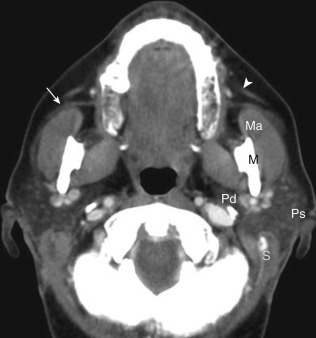
The parapharyngeal fat is a good marker for telling what space a lesion is in ( Table 14-1 ) in the deep neck by its displacement. Deep parotid space lesions displace the parapharyngeal fat anteromedially and maintain a fat plane between the lesion and the mucosal surface of the pharynx.
| Lesion Location (Space) | Displacement of Parapharyngeal Fat | Displacement of Styloid Musculature | Displacement of Longus Musculature |
|---|---|---|---|
| Parotid deep portion | Anteromedial | Posterior | Posterior |
| Masticator | Posteromedial | Posterior | Posterior |
| Carotid | Anterior | Anterior | Posterior |
| Mucosal | Posterolateral | Posterior | Posterior |
| Retropharyngeal | Anterolateral | Anterior | Posterior |
| Perivertebral | Rarely displaced | Anterior | Anterior |
| Parapharyngeal | N/A | Posterior | Posterior |
The parotid duct is termed the Stensen duct, and it passes over the masseter muscle before curving medially to insert in the cheek at the second maxillary molar. Because the parotid gland is late in its encapsulation, lymphoid tissue lies within it. For that reason, the parotid gland is the only salivary gland that has the potential for lymphadenitis, metastases to intraglandular lymph nodes, lymphoma, and autoimmune lymphocytic disorders.
The submandibular space ( Box 14-1 ) encompasses the tissue below the mucosa of the floor of the mouth yet above the fascia connecting the mandible to the hyoid bone. As such, it contains the sublingual compartment with the mylohyoid muscle, sublingual gland, portions of the submandibular gland, the associated ducts, and the corresponding neurovascular structures. The sublingual space communicates with the submandibular space along the posterior margin of the mylohyoid muscle.
The submandibular gland is located in the floor of the mouth, deep to the angle of the mandible ( Fig. 14-2 ). The submandibular gland secretes seromucinous saliva as opposed to the parotid gland, which secretes serous saliva. In addition, the pH of the saliva produced by the submandibular gland is more alkaline and the fluid is more viscous. The duct of the submandibular gland is called the Wharton duct, and it drains on either side of the frenulum of the floor of the mouth. The duct has a tighter orifice but is wider than the Stensen duct and is more easily traumatized in the mouth. The duct of the submandibular gland courses anteriorly and superiorly before reaching its orifice.
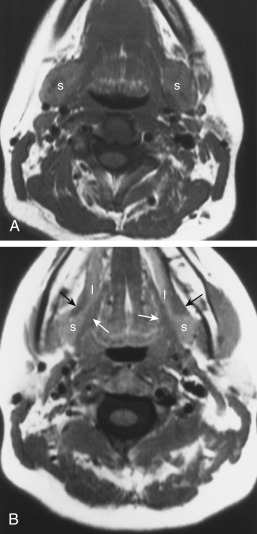
The sublingual gland is located in the sublingual space medial to the mylohyoid muscle in the floor of the mouth. The size of the sublingual gland ranges from being inapparent on imaging studies to a readily identifiable almond sized structure. The sublingual gland has many draining ducts (known as ducts of Rivinus) opening below the tongue. If a dominant sublingual duct connects to Wharton duct, it is called the duct of Bartholin (don’t get the Bartholin duct in the mouth mixed up with the Bartholin duct of the vagina….nuf said!). The saliva produced by the sublingual gland is also seromucinous. It is the smallest of the major salivary glands and has the fewest lesions associated with it, but it does get in the path of floor of the mouth squamous cell carcinoma.
Minor salivary glands are found scattered throughout the aerodigestive system but abound in the oral cavity (especially the hard and soft palate). Minor salivary glands can also be found in the oropharynx, nasopharynx, sinonasal cavity, the parapharyngeal space, the larynx, the trachea, the lungs, and even into the middle ear and eustachian tube. These glands secrete mucinous saliva. Minor salivary glands do not have readily identifiable ducts; however, they are the source of the many mucous retention cysts that are seen as benign lesions in the aerodigestive system. Neoplasms of minor salivary glands have been addressed in the mucosal chapter ( Chapter 13 ); suffice it to say pleomorphic adenomas and adenoid cystic carcinomas are the most common benign and malignant histologies respectively.
Now that the hors d’oeuvres have been served and your appetite has been whetted, you are ready to digest diseases of the salivary lesions.
First branchial cleft cysts (BCCs) classically occur in the parotid gland ( Box 14-2 ) or around the external auditory canal (EAC). Several classifications of first BCCs have been developed including Arnot type I (intraparotid cyst) and Arnot type II (cyst in the anterior neck that may drain with a tract through the deep portion of the parotid gland to the EAC; Figs. 14-3 and 14-4 ). Work type I first BCCs are anterior and inferior to the pinna and may communicate with skin anterior and medial to the EAC in the preauricular zone. Work type II BCCs are more common, arise at the angle of the mandible (where we typically see second BCCs), and extend to the junction of the bony and cartilaginous EAC. They may rarely drain into the EAC. Both types of first BCCs may be intimately associated with the facial nerve which gives the ear, nose, and throat (ENT) surgeons fits. Because second BCCs are so much more common, they probably outnumber first BCCs even in the periparotid location ( Table 14-2 ).
Abscesses
Branchial cleft cysts (BCCs)
Lymphoepithelial lesions
Pleomorphic adenomas and Warthin tumors
Pseudocysts
Sialectasis
Sialoceles
Simple cysts
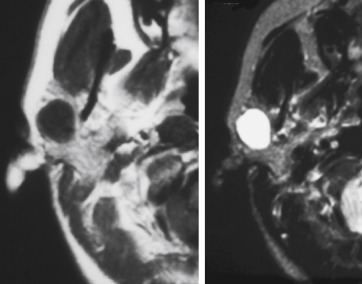
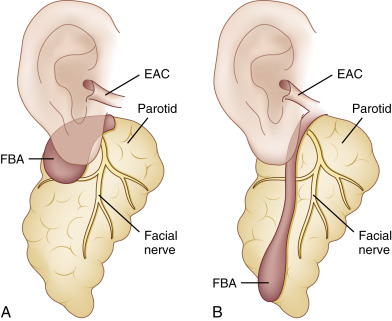
| Features | BCC type 1 | BCC type 2 | BCC type 3 | BCC type 4 |
|---|---|---|---|---|
| % of all BCCs | 7 | 90 | 2 | 1 |
| Location | Inferoposteromedial to pinna Angle of mandible to EAC Periparotid |
Anterior to mid SCM, deep to ICA Angle of mandible At CCA bifurcation Parapharyngeal |
Anterior to lower SCM, superficial | Low, anterior to SCM Left side in 90% Follows recurrent laryngeal nerve |
| Sinus drainage | Ear, skin | Tonsillar fossa, skin | Pyriform sinus | Pyriform apex |
| Etiology | Persistent cleft | Failure of arch to proliferate, persistent cervical sinus | Persistent cervical sinus | Persistent cervical sinus |
Although these lesions usually have fluid density and intensity characteristics, if infected or traumatized, their appearance may be a bit more complex (see Fig. 14-3 ). Adjacent inflammation may be present, and the whole complex may simulate an infiltrative process. Fistulization to the bone-cartilage junction of the external ear may occur with first branchial cleft anomalies.
Venous vascular malformations (formerly inaccurately called hemangiomas because they are not tumors) may occur in the submandibular space as well as in other spaces of the head and neck. On CT, they may show phlebolithic calcification in their later stage (as opposed to monolithic ossification of the Stone Age), but invariably one identifies a lobulated, heterogeneously enhancing mass. Areas of enhancement that are as extensive/intensive as that of the neighboring jugular vein are not unusual. If you perform a fine-needle aspiration (FNA) of this lesion you will be faced with the bane of the aspirator’s existence—recurrent samples of “nothing but blood.” You will be doing the study in vein (Ha! Pun-ishment again!). Do not bother. Interestingly enough, there is a 20% coincidence rate of developmental venous anomalies (venous angiomas) of the brain in those subjects with head and neck venous malformations.
By our estimation, calculous disease (in the nonmathematical sense) is the most common benign condition to affect the salivary glands by a factor of the (π 3 !3) 4 . Because the submandibular gland secretes a more mucinous, viscous, alkaline saliva and the wider duct must drain in an uphill direction with greater possibility of stasis, calculi occur most commonly in the Wharton duct ( Fig. 14-5 ). In fact, submandibular gland calculi outnumber those in the parotid gland by a “calculation” of four to one. Sublingual gland calculi and minor salivary gland calculi are extremely uncommon. Although most of the calculi associated with the salivary glands are radiopaque, a small percentage of calculi (20%) may not be so radiodense as to be visible on plain films. Viva La CT!
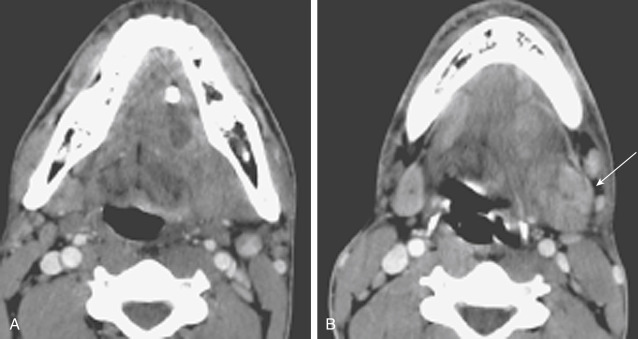
Patients who have calculous disease usually have painful glands, exacerbated by chewing foods that precipitate salivation. If the clinician suspects calculous disease, the usual work-up includes plain films to evaluate for large radiopaque calculi. If no calculi are identified by plain films, or if the patient has a fever associated with a painful salivary gland and an abscess is suspected, CT should be done because it is more sensitive for the detection of calcification and inflammatory masses ( Fig. 14-6 ). This may be one of the rare indications for unenhanced (to see a small calculus and distinguish it from a vessel) and enhanced (to look for signs of inflammation/abscess) CT examinations of the neck. Remember that magnetic resonance (MR) imaging is less sensitive to calcified or noncalcified tiny calculi; larger calculi can be seen as low-intensity areas on T2-weighted scans but flow voids of vessels may simulate calculi.

Calcifications of the parotid glands are also associated with human immunodeficiency virus (HIV) infection, chronic kidney disease, alcoholism, elevated alkaline phosphatase, and autoimmune disease, including sarcoidosis and systemic lupus erythematosus.
In the instance of a calculus that is not radiopaque on CT, one might be forced to perform conventional sialography (cannulation of the salivary duct with injection of contrast). MR sialography can employ either a single shot fast spin echo heavily T2-weighted sequence that highlights the ducts alone or a high-resolution three-dimensional fast spin echo or constructive interference in steady state (CISS) T2-weighted sequence. Sialography is useful in demonstrating strictures of the ducts after passage of a calculus and intraluminal filling defects from nonopaque stones. The sialogram suggests the diagnosis of autoimmune/chronic sialadenitis if there are pruned, truncated main ducts with punctate/globular collections peripherally in the glandular parenchyma.
Treatment of sialolithiasis (a catchy seven-syllable word for salivary gland stones) generally consists of supplying sour solutions to stimulate salivation to spew said stone (say that 10 times fast without spitting!). Transoral resection and sialodochoplasty can be performed for isolated distal duct (close to ampulla) sialoliths. For proximal or glandular stones, the surgeon may decide to treat the patient with resection of the gland. This is often the preferred treatment with recurrent bouts of sialolithiasis with disruptive sialadenitis. A cervical (submandibular) approach may be taken with sialoliths that extend beyond the mylohyoid (in the proximal duct).
Sialosis is a painless enlargement of the parotid glands that has been associated with numerous causes, including (1) diabetes, (2) alcoholism, (3) hypothyroidism, (4) medications including phenothiazines and some diuretics, (5) obesity, (6) starvation, (7) radiation, and (8) the dreaded “idiopathic” causes. This usually is a bilateral and symmetric process that may resolve when the underlying cause has been removed. It should be noted, however, that the normal range of parotid gland size and consistency is varied and often it is difficult to state definitively that the glands are larger than normal. On imaging studies the glands with sialosis generally have a CT density and signal intensity on T2-weighted imaging (T2WI) slightly greater than that of normal fatty parotid glands. The glands in sialosis usually are not as bright on T2WI as glands that are infected. You may see distortion of the facial contour by the enlarged glandular tissue.
Sialadenitis refers to glandular inflammation, whereas sialectasis refers to dilatation of ductal spaces. Sialadenitis is often associated with sialectasis. The most common cause of these conditions is calculous disease. The inflamed gland is enlarged and hyperenhancing on CT and MR imaging compared with the contralateral normal side and periglandular stranding can be seen. Microabscesses within the parotid tissue may be seen in a person who has sialectasis and/or sialadenitis. They are identified on CT as areas of low density with peripheral rim enhancement and on MR as areas of very bright signal intensity on T2WI of the salivary glands. Microabscesses are often multiple and may be a source of painful parotid glands with fever. Abscesses may also develop around the mandible, sublingual gland, or submandibular gland in association with dental infections ( Fig. 14-7 ).
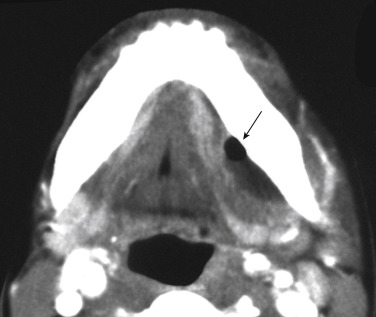
A wide variety of inflammatory conditions may affect the salivary glands. Although mumps may be the most common infection to affect the salivary glands (specifically the parotid glands), imaging is unnecessary; the diagnosis is a clinical one. Other viral etiologies include HIV, coxsackie, and influenza viruses. Bacterial infections are uncommon and are usually due to Streptococcus, Haemophilus, and Staphylococcus species.
Other etiologies of acute parotitis include granulomatous (tuberculosis, candida, cat scratch fever) and idiopathic causes (e.g., postpartum parotitis). Poor dental hygiene may contribute to the development of infections affecting the submandibular, sublingual, and parotid glands. The minor salivary glands rarely show inflammatory change other than mucous retention cysts from local obstruction. Vallecular retention cysts, believed to arise from salivary tissue at the tongue base, can get huge.
Sialodochitis refers to inflammation of the main salivary ductal system. A number of autoimmune conditions may cause sialadenitis and sialodochitis. Mikulicz disease, or in the most recent classification, Sjögren type 1 disease (poor Dr. Mikulicz is getting squeezed out), is an autoimmune disorder that causes chronic sialadenitis and sialodochitis and leads to fibrous salivary gland tissue (primarily of the minor glands) with resultant dry mouth. This disorder usually affects middle-aged women. They have a higher rate of stones also so do the scan “dry” (Ha!). When the disease is associated with a collagen-vascular disease (most commonly rheumatoid arthritis more so than systemic lupus erythematosus) and there is involvement of the lacrimal glands, the disorder is classified as Sjögren syndrome (Sjögren type 2). Sjögren syndrome is an autoimmune disorder that causes dry eyes, dry mouth, and arthritis. Patients with Sjögren syndrome have a 10-fold increased risk of lymphoma, which may have its first manifestations in the parotid glands. The lymphoma is usually of the non-Hodgkin variety and may also affect any other area of the head and neck ( Fig. 14-8 ). These patients are often scanned to survey for the possibility of lymphoma.
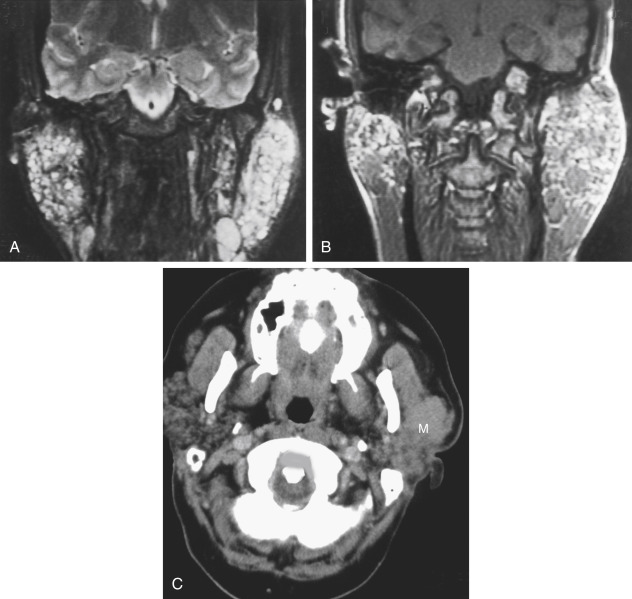
Sjögren syndrome is characterized on conventional or MR sialography by punctate, globular, cavitary, or destructive appearance of the ducts of the parotid glands. Tiny pools of contrast may be seen in the gland. With increasing severity of disease there is greater and greater replacement of glandular tissue with fat. Thus, some have suggested that the severity of fat deposition correlates well with the impairment of salivary flow in Sjögren patients. Sjögren syndrome is also associated with the presence of lymphoepithelial cysts and nodules akin to those seen in patients with HIV-associated parotid lesions (see following discussion).
The cross-sectional imaging appearance of parotid glands in patients who have Sjögren disease may range from normal to a dried up, scarred down, atrophic gland, to one with lots of large and/or tiny cysts and nodules within it, to one with a dominant mass within it. This looks very much like acquired immunodeficiency syndrome (AIDS)–related parotid disease (see later discussion).
The glands with autoimmune sialadenitis generally are denser on CT than normal. Some authors have described a “salt and pepper” appearance (there is that same old food analogy) to the gland on both T1-weighted imaging (T1WI) and T2WI in 46% of patients with Sjögren syndrome, presumably reflecting fibrosis and lymphocytic infiltration intermixed with sialectasis. Biopsy should be performed on any dominant mass to rule out lymphoma.
Since the ascent of AIDS in the young population, lymphoepithelial lesions of the parotid gland have become much more common. These may include purely cystic lesions or solid lesions of lymphoid aggregates ( Fig. 14-9 ). Therefore, in a younger patient with multiple lesions in the parotid gland, you should consider lymphoepithelial lesions as opposed to multiple Warthin tumors. The differential diagnosis also includes multiple intraparotid lymph nodes and/or lymphoma. The lymphoepithelial lesions of the parotid have been associated with HIV seropositivity, and the presence of these abnormalities may predate the infection that classifies the patient as having AIDS. Associated findings with the HIV-related parotid disease include diffuse generalized lymphadenopathy in the neck and prominence of adenoidal and tonsillar tissue. Bone marrow signal intensity on T1WI may be lower than normal. When the lymphoepithelial lesion is cystic, it has low density on CT and signal intensity characteristics of cerebrospinal fluid on T1WI and T2WI. However, the lymphoepithelial solid nodules may have a more variable density and signal intensity on cross-sectional imaging. They are not distinguishable from Sjögren-related benign lymphoepithelial lesions (BLELs).
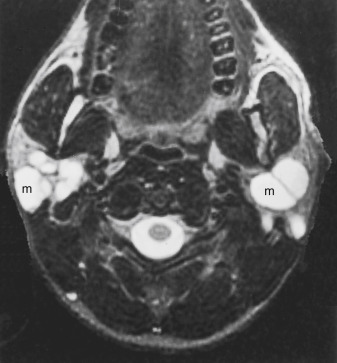
A sialocele refers to a collection of saliva that communicates with the parent duct in a manner similar to that of a pharyngocele or a laryngocele filled with fluid ( Fig. 14-10 ). The most common cause of sialoceles is penetrating trauma, although blunt trauma may also cause disruption of the duct and leakage of salivary contents into the parenchyma and outside the gland. This most commonly occurs in the parotid gland, either from a punch to the side of the face or from a stab wound. The entity is distinguished from a pseudocyst because it communicates with the parent duct and is not lined by fibrous tissue.
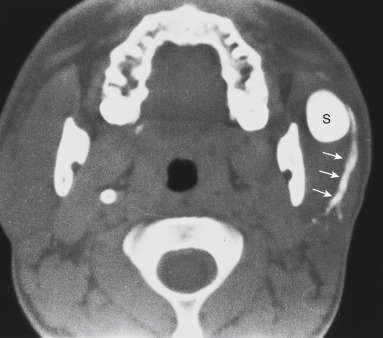
This is a postinflammatory pseudocystic lesion that results from obstruction and focal rupture of either the sublingual or submandibular duct and that produces a cystic mass either confined by the mylohyoid muscle (simple ranula, epithelial lined) or extending to the submandibular region (a plunging ranula, not epithelial lined) by passing through the mylohyoid dehiscence known as the “boutonniere” (see Fig. 13-24 ). The name ranula is derived from the word “rana,” which means frog in Latin, since the shape of the pseudocyst has been likened to that of a frog. A ranula has also been termed a “mucous escape cyst,” a mucous retention cyst, and a mucocele of the sublingual gland or neighboring minor salivary glandular tissue. The simple ranula is usually addressed transorally, but may be treated with resection or, in some cases, marsupialization. The lingual and hypoglossal nerves must be carefully identified during the operation. A plunging ranula may be excised through a transcervical submandibular incision with a neck dissection. This allows complete resection of the cyst and will help spare the lingual and hypoglossal nerve. Alternatively, the surgeon may excise the sublingual gland transorally and pack the cyst or place a drain in it. By treating the gland, some believe the plunging cyst will resolve on its own.
Retention cysts are very common benign “masses” that result from inflammation and obstruction of minor salivary gland ducts and therefore may be seen throughout the aerodigestive system’s mucosal surface.
Sarcoidosis may also affect the parotid gland, usually manifesting as bilaterally enlarged glands with multifocal nodules. Gallium uptake on nuclear medicine scans may be striking. Multiple tiny calcifications in the parotid glands may be seen in sarcoidosis, Sjögren, tuberculosis, and lupus.
A mucus plug in the duct may also cause a painful swollen gland (Kussmaul disease). An inflammatory pseudomass associated with calcifications in the gland is termed the “Kuttner tumor,” a focal firmness of the submandibular gland caused by chronic sialadenitis from sialolithiasis.
There is an adage that salivary glands are unlike National Football League middle linebackers—the larger they are, the less malignant they are. Thus, the rate of malignancy increases from 20% to 25% in the parotid gland to 40% to 50% in the submandibular gland and 50% to 81% in the sublingual glands and minor salivary glands. The larger the size of the gland, the higher the rate of benign versus malignant tumors, at least in adults. In contradistinction to adults, the larger the gland of origin of the tumor in children, the more likely the tumor will be malignant. In children, 90% to 95% of salivary tumors occur in the parotid and 5% occur in the submandibular and sublingual glands. Sixty-five percent of salivary gland neoplasms in children are benign.
Although CT and MR dominate the evaluation of the major salivary glands for neoplasms, do not count sonography out completely, particularly if you live on the fish-and-chips/paella/bratwurst/borscht side of the Atlantic. It has been reported that 95% of space-occupying lesions of the major salivary glands can be completely delineated by sonography. All salivary gland neoplasms are hypoechoic to normal glandular tissue. Ultrasound (US) correctly assesses whether a lesion is benign or malignant in 90% on the basis of definition of the margins of the tumor, but 28% of malignant lesions may be misinterpreted as being benign. Sonography differentiates extraglandular from intraglandular lesions with an accuracy of 98% (all mistakes were periparotid lymph nodes). The authors hope that this last paragraph will help the overseas sales of our book despite France’s arguments with our foreign policy (now back to costly CT and MR!).
Nearly 80% of benign parotid neoplasms are pleomorphic adenomas ( Box 14-3 ). Pleomorphic adenomas, also known as benign mixed tumors (BMT), occur most commonly in middle-aged women. Most pleomorphic adenomas are well-defined lesions that commonly appear solid and round. Pleomorphic adenomas are well identified on both CT and MR against the fatty background of the normal adult’s parotid gland ( Fig. 14-11 ). On CT, the lesions have density similar to that of muscle and demonstrate mild to moderate enhancement. On dynamic MR and CT scanning, a time to peak of less than 120 seconds and washout ratio of less than 30% suggests malignant tumors over benign with 91% accuracy. This appears to correlate with microvessel count and cellularity. An overlap of peaks between malignancies and Warthins occurred but not with washout ratios.
80% of parotid tumors are benign
80% of benign parotid gland tumors are pleomorphic adenomas
80% of salivary gland pleomorphic adenomas occur in parotid gland
80% of parotid pleomorphic adenomas occur in superficial lobe
80% of untreated pleomorphic adenomas remain benign; 20% ultimately undergo malignant change
80% of what people read is not retained after 2 weeks

With a delay, one may see an increase in the degree and homogeneity of enhancement in parotid pleomorphic adenomas. On MR, the lesions are best identified on T1WI amid the bright signal of the parotid fat; however, they are usually seen on T2WI as very bright lesions (add that to your 80% rule; 80% of bright lesions in the parotid are pleomorphic adenomas). Additional MR findings include a complete capsule (often low intensity on T2WI) and a lobulated contour. Pleomorphic adenomas inconstantly have cystic degeneration or calcification within them. Because the incidence of calcification is so much lower in other types of parotid tumors, the presence of calcification nonetheless suggests pleomorphic adenoma.
Pleomorphic adenomas are the most common tumor of the parotid gland in both its superficial and deep portions. In fact, pleomorphic adenomas are the most common benign tumor of the submandibular, sublingual, and minor salivary glands. If you guess pleomorphic adenoma, you will have a better batting average than Ted Williams. They are multicentric in 0.5%, but as they account for 80% of benign tumors and benign tumors are 80% of all tumors, this means that approximately 3% of multiple parotid neoplasms are pleomorphic adenomas.
If left alone to grow, a pleomorphic adenoma will degenerate into or coexist with a carcinoma ex pleomorphic adenoma in a significant (10% to 25%) percentage of cases within 25 years. Yelled the ENT surgeon, “Cut it out!” It is not known whether a carcinoma is present within the pleomorphic adenoma from its outset (malignant mixed tumor) or whether this is a manifestation of malignant transformation (carcinoma ex pleomorphic adenoma), but most pathologists favor the latter theory ( Fig 14-12 ). The luminal epithelial cells undergo malignant change more commonly than the myoepithelial cells. In any case, it is because of this carcinomatous association that pleomorphic adenomas are removed in their entirety with a cuff of normal salivary tissue in most instances.
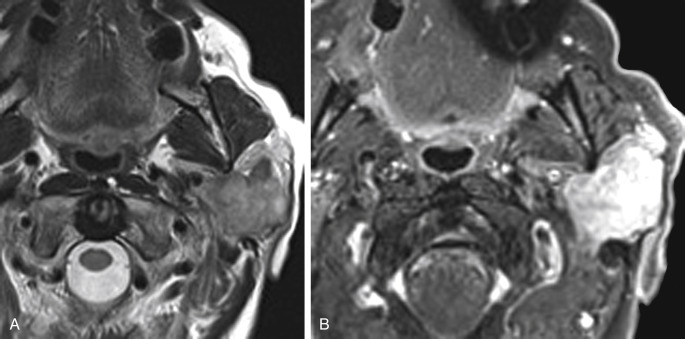
Rarely, they may metastasize (metastasizing pleomorphic adenoma). The average age of carcinoma ex is 20 years older than pleomorphic adenoma, lending support to the theory of malignant degeneration of a benign tumor.
Monomorphic adenomas (myoepitheliomas, oncocytic adenomas, canalicular adenomas) look very much like pleomorphic adenomas but are more commonly seen in submandibular glands. They are well defined and enhance.
Warthin tumors are also known as cystadenoma lymphomatosum. Guess what? They can be cystic or lymphoma-like in their appearance. These tumors are nearly exclusive to the parotid gland and are the most common multiple and bilateral tumors in the parotid ( Box 14-4 ). As opposed to pleomorphic adenomas, which are generally seen in middle-aged women, Warthin tumors are most commonly seen in elderly men. Warthin tumors may have a tumoral cyst and favor the parotid’s tail (think dirty old men chasing tail). These lesions are entirely benign and show no evidence of malignant transformation. Therefore, if an FNA identifies a lesion as a Warthin tumor, surgeons may conservatively watch the tumor rather than remove it, although that may break their heart. On MR, the lesions are well seen hypointense masses on T1WI contrasting with the native high signal intensity of the parotid gland. However, the signal intensity on T2WI is often heterogeneous and variable and may overlap that of the bright signal of pleomorphic adenomas ( Fig. 14-13 ) or the darker intensity of malignancies of the parotid gland (see following section). Warthin tumors, like oncocytomas, have increased uptake on technetium 99m pertechnetate nuclear medicine scans. Therefore, if an FNA is equivocal or nondiagnostic, you could recommend a nuclear medicine technetium scan to make the diagnosis of Warthin tumor.
Lymph nodes (normal or abnormal)
Lymphoepithelial lesions
Lymphoma
Pleomorphic adenomas
Metastases
Warthin tumors
Sarcoidosis
Sjogren syndrome
Acinic cell carcinomas
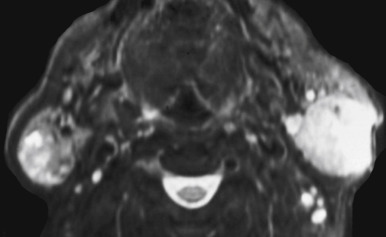
The oncocytoma is a relatively rare benign tumor almost exclusively seen in the parotid gland (of the salivary glands). These lesions have been called the vanishing parotid mass because, while they are hypointense on T1WI, they are isointense to the native parotid gland on fat-saturated T2 and postcontrast T1 imaging. The tumors may also take up technetium on nuclear medicine scans.
Hemangiomas are the most common salivary gland tumors seen in children, girls more than boys. Hemangiomas enhance brightly and are very hyperintense on a T2WI. Cutaneous hemangiomas may coexist. Congenital capillary hemangiomas represent 90% of parotid gland tumors in neonates. They will undergo spontaneous resolution by adolescence in most cases. Low-flow vascular malformations of lymphatic and venous origin are the next most common benign lesions to affect pediatric parotid gland. The third most common benign tumor of the pediatric parotid gland is the pleomorphic adenoma.
Lipomas, schwannomas ( Fig. 14-14 ), and neurofibromas may also be seen in association with the salivary glands, most commonly the parotid. Lipomas have fat density and present in children. The neurogenic tumors generally follow cranial nerves V (submandibular, sublingual, and parotid glands) or VII (parotid glands). Be careful to trace these tumors along the expected course of the nerves, even to their foramina. What lies at the bottom of the ocean and twitches? A nervous wreck.
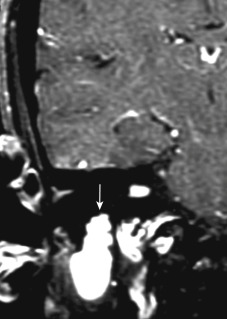
Patients with parotid malignancies usually have a palpable, discrete, painless mass (98% of cases). Other presentations include facial nerve dysfunction (24%) and cervical adenopathy (6%). Facial nerve paralysis associated with a parotid mass usually means a malignancy is present. Of the malignancies to cause a facial nerve paralysis, adenoid cystic carcinoma and undifferentiated carcinoma predominate. The staging of malignant salivary gland lesions is outlined in Box 14-5 .
TX—Tumor that cannot be assessed
T0—No evidence of primary tumor
T1—Tumor <2 cm in diameter without extraparenchymal extension
T2—Tumor >2 cm but <4 cm in diameter without extraparenchymal extension
T3—Tumor >4 cm and/or tumor having extraparenchymal extension ∗
∗ Note: Extraparenchymal extension is clinical or macroscopic evidence of invasion of soft tissues. Microscopic evidence alone does not constitute extraparenchymal extension for classification purposes.
T4a—Tumor invades the skin, mandible, ear canal, and/or facial nerve
T4b—Tumor invades skull base and/or pterygoid plates and/or encases carotid artery
NX—Regional lymph nodes cannot be assessed
N0—No regional lymph node metastasis
N1—Metastasis in single ipsilateral lymph node, 3 cm in greatest dimension
N2—Metastasis in single ipsilateral lymph node, >3 cm but <6 cm in greatest dimension, or multiple ipsilateral lymph nodes, none >6 cm in greatest dimension, or bilateral or contralateral lymph nodes, none >6 cm in greatest dimension
N2a—Metastasis in single ipsilateral lymph node >3 cm but <6 cm in greatest dimension
N2b—Metastasis in multiple ipsilateral lymph nodes, none >6 cm in greatest dimension
N2c—Metastasis in bilateral or contralateral lymph nodes, none >6 cm in greatest dimension
N3—Metastasis in lymph node >6 cm in greatest dimension
MX—Presence of distant metastasis cannot be assessed
M0—No distant metastasis
M1—Distant metastasis
The differentiation of deep or superficial parotid malignancies is critical from the standpoint of the extent of dissection needed to separate the nerve from the tumor or to gain access to the tumor, the attendant risk to the facial nerve, and in the case of tumors extending into the parapharyngeal space, the need for a cervical approach with or without mandibulotomy. Demonstration or suspicion of direct invasion of the nerve at the stylomastoid foramen (or above) prods the surgeon to plan for transmastoid (temporal bone surgery) identification of the facial nerve to control disease and prevent tumor spillage. The superficial parotidectomy thereby becomes skull base surgery with its attendant risks (to the other cranial nerves, venous sinuses, carotid artery, and temporomandibular joint function) and morbidity. If the skull base is invaded, the cartilaginous auditory canal may have to be addressed and possibly resected. A radical mastoidectomy is contemplated and even the ascending ramus of the mandible may be removed.
The main role of the radiologist in the evaluation of malignant parotid masses, because there are no specific imaging findings to suggest a specific histologic diagnosis, is to describe the location of the lesion (deep versus superficial), assess for lymphadenopathy or extraglandular spread, and detect perineural tumor spread that would render a diagnosis of malignant neoplasm more likely and influence the surgical/therapeutic approach. But, like political pundits, we enjoy speculating on the ultimate (histologic/political) winner (diagnosis) and the route to the endpoint. Don’t beat around the Bush, Rand-er a diagnosis, and tell the pathologist to “Trump that!”
Mucoepidermoid carcinomas account for 30% of all salivary gland malignancies, and is the most common malignant lesion of the parotid gland (60% of them occur in the parotid gland; Fig. 14-15 ). Mucoepidermoid carcinomas, like squamous cell carcinoma, can be graded from low to high, and the prognosis varies with the grade. Mucoepidermoid carcinoma is the most common pediatric salivary gland malignancy. Thirty-five percent of salivary gland neoplasms in children are malignant and of these, 60% are mucoepidermoid carcinomas. Primary salivary gland lymphoma does occur in the parotid gland as can leukemic infiltration in children.
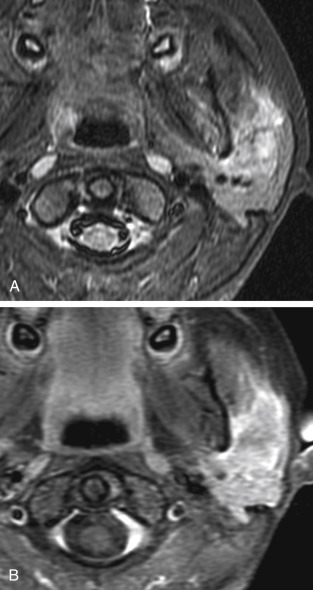
In the parotid gland, a lesion’s morphology may be misleading as far as predicting benignity versus malignancy. Some pleomorphic adenomas have tentacles with an irregular margin. By the same token, some mucoepidermoid carcinomas are well defined by a pseudocapsule and do not appear to be invasive. Therefore, you cannot rely on definition of margins to distinguish cancer from benign tumors. Just like shape cannot differentiate one Jenner from the true Jenner.
On CT, most tumors of the parotid gland have a density equal to muscle—no help there. Low-grade mucoepidermoid carcinomas may have high T2W signal intensity, but high-grade, poorly differentiated mucoepidermoid carcinomas and parotid malignancies of other histologies are usually low in intensity on T2WI. A useful adage is that if the T2W signal intensity is low, the lesion should be biopsied for probable malignancy (careful, Warthin tumors may be dark on T2WI and simulate a high-grade mucoepidermoid carcinoma). If the lesion is bright on T2WI, you can assume it is a pleomorphic adenoma and proceed accordingly without presurgical sampling. MR also does well in demonstrating the perineural, vascular, and dural invasion that may be present with parotid malignancies. Malignancies enhance, have low apparent diffusion coefficient (ADC) values, and have lower blood flow and blood volume (compared with benign parotid tumors in contradistinction to brain tumors).
Adenoid cystic carcinoma (ACC) is the second most common primary malignancy of the parotid gland and the most common tumor of the submandibular, sublingual, and minor salivary glands. Similar to the mucoepidermoid carcinoma, variable intensity occurs with the T2WI ( Fig. 14-16 ). Noncystic ACC masses in the parotid gland have muscular CT density, low intensity on T1WI, and mild to moderate enhancement. ACCs are notorious for their propensity for perineural spread (50% to 60%) and persistence despite “complete surgical removal.” They are like dust mites; you cannot get rid of them, they keep multiplying, and you learn to live with them. An ACC of the parotid gland may spread via the ramifications of cranial nerve VII retrograde into the temporal bone or may spread via the auriculotemporal branches of cranial nerve V to the Meckel cave region through the foramen ovale (see Fig. 14-16, B ). In the other salivary glands, adenoid cystic carcinoma generally demonstrates perineural extension along the branches of the second and third divisions of cranial nerve V. This cancer is a relentless, slow-growing tumor whose prognosis is generally measured in terms of decades rather than 5-year survival rate because of its prolonged course.
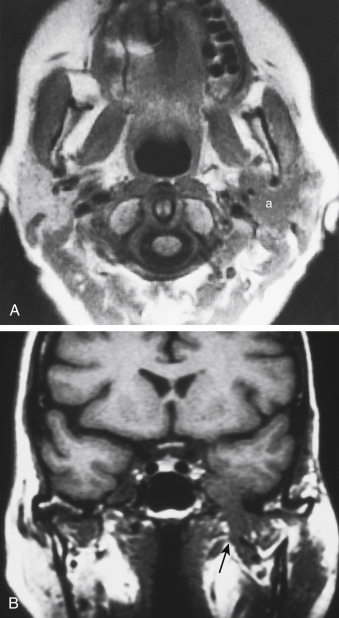
Squamous cell carcinoma may be seen within the parotid gland. Sometimes it is difficult to tell whether the squamous cell carcinoma is present secondarily because of invasion of lymph nodes from a primary site outside the parotid or is intrinsic to the parotid gland ( Fig. 14-17 ). How it gets there is mysterious because squames are not intrinsic to glandular tissue; they are presumably caused by metaplasia of the ductal columnar epithelium into squamous cells. This same difficulty lies with lymphoma of the parotid—is it a primary parotid tumor or secondary spread? When multifocal in the parotid, it is generally accepted that the squamous cell carcinoma is probably within lymph nodes in the parotid gland. A search for a primary tumor is undertaken in the overlying skin and ear as primary sites that drain to the parotid gland. Squamous cell carcinoma does not generally occur in submandibular, sublingual, or minor salivary glands as a primary site, although it certainly spreads to them from adjacent mucosal surfaces. Squamous cell carcinomas are virtually always hypointense on T2WI unless necrosis coexists.

Adenocarcinomas may also arise within the parotid gland, sublingual gland, submandibular gland, or minor salivary glands. This lesion generally has a worse prognosis than that of mucoepidermoid carcinoma and adenoid cystic carcinoma ( Box 14-6 ). This tumor is derived from the glandular tissue itself as opposed to ductal tissue. Signal intensity is variable, depending on mucinous, cystic, or solid contributions, but usually dark on T2WI and enhance. Remember that some adenocarcinomas (carcinoma ex) occur from malignant degeneration of pleomorphic adenomas.
The polymorphous low-grade adenocarcinoma of the salivary gland (PLAC) is a low-grade neoplasm that predominantly occurs in the minor salivary glands of the oral cavity (mucosa of the soft and hard palates, in the buccal mucosa, and in the upper lip) but can be seen in the parotid gland. It has a much more benign prognosis and course than the traditional butt-kicking adenocarcinoma.
Acinic cell carcinoma ( Fig. 14-18 ) is the most common primary multifocal malignancy to affect the parotid gland. Its prognosis is intermediate between that of mucoepidermoid carcinoma and adenocarcinoma of the parotid gland. This tumor is seen almost exclusively in the parotid gland, and the incidence of bilateral acinic cell carcinomas is approximately 1% to 3%. No specific imaging features other than its multifocality suggest this diagnosis. Consider it the spitting image of adenocarcinoma (pun-time!)
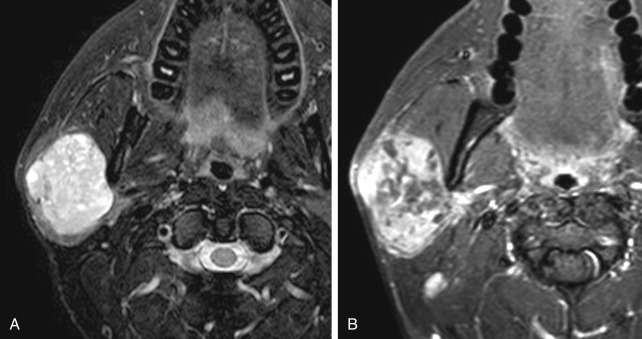
Undifferentiated carcinoma is also seen as a salivary gland tumor. This lesion has a very poor prognosis but fortunately is rarely seen.
The incidence of nodal metastases in untreated parotid cancers is low except in T3 or T4 lesions. Although mucoepidermoid carcinoma and squamous cell carcinoma metastasize to nodes in 37% to 44% of cases, the other histologic types are only associated with lymphadenopathy in 5% to 21%, with adenoid cystic carcinoma being the lowest. ACC “plucks” your nerves instead of nodes.
The masticator space is defined by layers of the deep cervical fascia and encompasses the muscles of mastication (the medial and lateral pterygoid, masseter, and temporalis muscles) as well as the condyle and ascending ramus of the mandible, branches of the external carotid artery and third division of cranial nerve V, and venous branches from the jugular system ( Fig. 14-19 ). Of the muscles of mastication, the small lateral pterygoid has a primary function of opening the mouth, whereas the bulky medial pterygoid, masseter, and temporalis muscles serve to keep the mouth closed. Given that the Lord has given us three huge muscles to keep our yappers shut and only one small one to open our mouths, you can see why we feel politicians and lawyers are defying the rightful laws of nature and should have their lateral pterygoids removed.
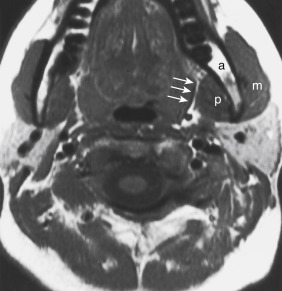
How do you identify a lesion as being within the masticator space? Chew on this: When a pterygoid masticator space lesion is present, the parapharyngeal fat is displaced posteromedially and may be infiltrated along its anterolateral aspect (see Table 14-1 ).
Most of the inflammatory lesions of the masticator space relate to infections of odontogenic origin ( Fig. 14-20 ). Therefore, abscesses around the teeth, osteomyelitis of the mandible, and cellulitis associated with carious teeth are the prime offenders in this category ( Fig. 14-21 ). Look for lucency surrounding the suspected tooth root. You could also see dehiscence of the adjacent maxillary or mandibular cortex, and there just might be an accompanying subperiosteal abscess. These might be small and difficult to really appreciate without intravenous contrast, but you should still look. Why? If not addressed, the infection can become quite extensive, involving other soft tissues of the face and neck, causing airway compromise (Ludwig angina), thrombophlebitis, and vision loss (from orbital extension). It is important to let the clinician know of the offending tooth, because no matter how the abscess gets drained, the problem won’t be solved until that tooth is dealt with. Dearest students, please floss regularly.
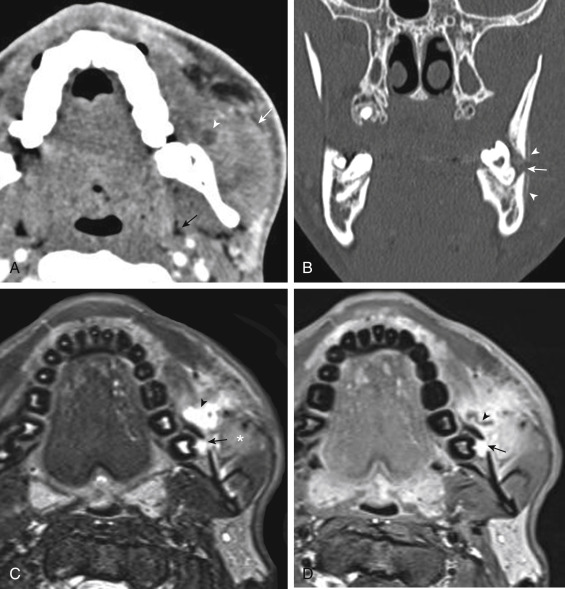
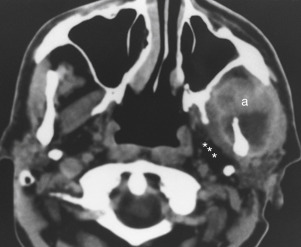
Occasionally, cellulitis and myositis of the masticator space develop as a result of penetrating injuries, superficial facial infections, sinus tracts, or adjacent parotitis. Most inflammatory lesions of the masticator space can be readily identified on CT or MR. On CT, look for thickening of the adjacent muscle, infiltration of the nearby fat, subcutaneous tissue, or skin with a stranding pattern to it, or a tract leading to the skin or mucosal surface. If an abscess has developed, it will appear in a fashion similar to abscesses elsewhere, with a low-density center and a peripheral enhancing rim, often bordering on the bad tooth. On MR, inflammatory lesions, because of their high water content from edema, are very bright on T2WI. There are some exceptions to this rule, namely actinomycosis (because of sulfur granule deposition) and fungal infections (because of paramagnetic iron and manganese accumulation).
Bruxism may develop in patients who constantly gnash their teeth. This is a fancy word for (usually) bilateral enlargement of the muscles of mastication. It occurs most commonly idiopathically but may develop as a result of malocclusion, excessive chewing, or clenching the teeth (as occurs when radiologists are called to the witness stand). Rarely, this may be a unilateral phenomenon. Conditions that can result in an enlarged appearance of the muscles of mastication are listed in Box 14-7 .
Bruxism
Neurofibromatosis
Beckwith Weidemann syndrome
Glycogen storage disease
Hypothyroidism
Lipodystrophy
Proteus syndrome
Alternatively, one may see atrophy of the muscles of mastication when one has a cranial nerve V abnormality ( Fig. 14-22 ). This may be caused by lesions in the peripheral branches of the third division of cranial nerve V. Perioperative injury may cause denervation atrophy as can trauma. With denervation atrophy one may see volume loss, fatty infiltration, enhancement after gadolinium administration and/or high signal intensity on T2W scans in the muscles of mastication (in reverse order chronologically). Neurogenic tumors may also induce these imaging characteristics.
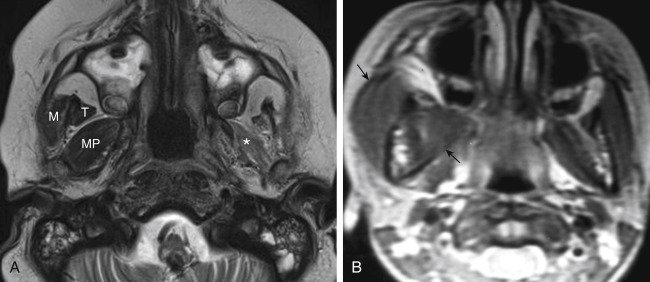
Fibrous dysplasia causes enlargement of the mandible and maxilla with expansion of the outer cortex of the bone, generally without erosion through the bone. McCune-Albright syndrome refers to precocious puberty, café-au-lait spots, and polyostotic fibrous dysplasia, (which may affect the mandible unilaterally) in girls. When a patient has bilateral bubbly bone lesions with a ground-glass appearance in the maxilla or mandible, consider either fibrous dysplasia or cherubism, which is a related disorder (see Fig. 13-21 , B ). Both of these disorders tend to expand during adolescence, are possibly related to hormonal influences, and either regress or stabilize in young adulthood.
The skull and facial bones are involved in 10% to 25% of cases of monostotic fibrous dysplasia and in 50% of polyostotic fibrous dysplasia. The mandible, maxilla, and calvarium are frequently involved.
The temporomandibular joint (TMJ) falls under the rubric of the masticator space. The TMJ may be the source of chronic facial or head pain. TMJ (or chronic maxillofacial pain) syndrome is seen in women nine times more frequently than men, is often precipitated by a traumatic event, and is very poorly understood, although, because it often regresses around menopause, is felt to be hormonally mediated. Presently, most imaging is performed with MR where the disk, condyle, glenoid fossa, and surrounding soft tissues may be evaluated. The disk has an anterior triangular band and a larger posterior band, which are joined in the middle by an intermediate zone ( Fig. 14-23 ). The posterior band is attached to the posterior joint by the retrodiskal tissue, or bilaminar zone. The disk should be centered over the condylar head in open- and closed-mouth positions on sagittal proton density‒weighted (PDW) MR with the posterior margin of the posterior band between the 11- and 12-o’clock point of the condyle in the closed-mouth position. The joint capsule itself has an anterosuperior compartment and an inferior compartment, which usually do not communicate, allowing effusions in multiple compartments. The lateral pterygoid muscle opens the jaw and inserts on the anterior portion of the disk. The medial pterygoid, temporalis, and masseter muscles close the jaw (except in lawyers).
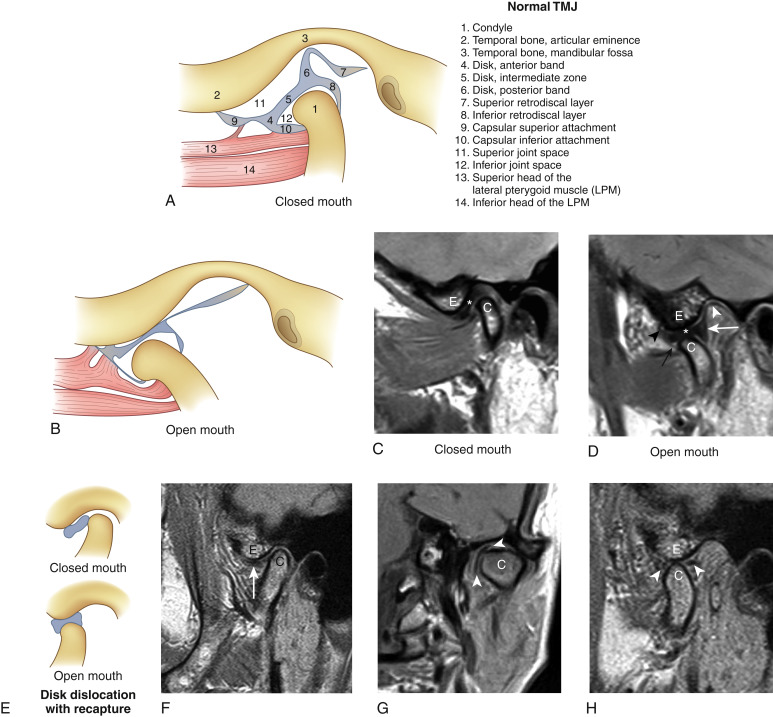
Anterior meniscal dislocations are the most common type in patients with TMJ complaints. In this setting, the disk’s posterior band is dislocated anteriorly from directly over the condyle. This posterior edge of the posterior band displacement is more than 10 degrees anterior to the 12-o’clock position, more like the 9- to 10-o’clock position. It may be far in front of the condyle in the closed-mouth position on sagittal PDW imaging. The dislocation may reduce on opening (often with a clicking sound—the “opening click”) and may redislocate on closing (a closing click). Thus, scanning is performed in closed and open mouthed views. Alternatively, the disk may remain anteriorly dislocated even on opening (“anterior displacement without recapture” is the phrase used in TMJ MR imaging). The location of the disk in front of the condyle may subsequently restrict the joint’s motion (a closed-lock situation).
A medial or lateral component in addition to the anterior dislocation (rotational dislocation) is not uncommon, said to occur in 25% to 30% of cases. Isolated medial and lateral (termed “sideways”) dislocations are relatively rare; however, with a transverse component the possibility of nonsurgical reduction of the dislocation is decreased (from 46% to 9%). For this reason a coronal MR in the closed mouth position should be performed and the disk must be assessed for medial or lateral offset from the condyle even as the disk is viewed anterior to that condyle in rotational dislocation. Posterior dislocations are extremely rare.
A stuck disk is one that does not move in open- or closed-mouth positions. It may or may not be anteriorly displaced, but it is usually fibrosed in and immobile. This may be associated with pain and disability.
Approximately 35% of subjects without TMJ symptoms have anterior dislocations, but 78% of patients with TMJ symptoms have disk displacements. The degree of disk displacement is greater in symptomatic than asymptomatic individuals and recapture of the displaced disk is less frequent in patients than asymptomatic volunteers (where it is the norm). Bilateral involvement is twice as common in patients as in volunteers. Clearly, the baseline incidence of this disease is very high.
What causes the pain? The size of TMJ effusions correlates well with subjective pain scales. To demonstrate an effusion, one performs a T2WI in the sagittal plane for bright fluid (see Fig. 14-23, K ). Other authors have focused on the retrodiskal tissues and believe that inflammation (again bright on the sagittal T2WI) there may irritate nerve fibers, accounting for the pain. The TMJ is to facial pain what the lumbar spine is to back pain. Shrug and call what you see.
MR is not able to detect disk perforations other than showing secondary findings of joint effusion and meniscal displacements. Arthrography or arthroscopy is the only means of demonstrating perforations. Perforations usually occur at the junction of the bilaminar zone with the posterior band. They occur more frequently with a transverse component to meniscal dislocations.
Initial treatment for TMJ syndrome is splinting, analgesics, behavior modification, and muscle relaxants. If the patient fails to respond to this noninvasive therapy and has meniscal abnormalities, plication of the disk into a more normal location or meniscal removal with or without prosthesis may be attempted. Adhesions may be lysed if present under arthroscopy. Complications related to the surgery including foreign body reactions, granular cell reactions, or avascular necrosis of the condylar head (which may also occur even without surgery). The latter may be identified as low signal intensity on all pulse sequences in the condylar head. Sclerosis is seen on CT ( Fig. 14-24 ).
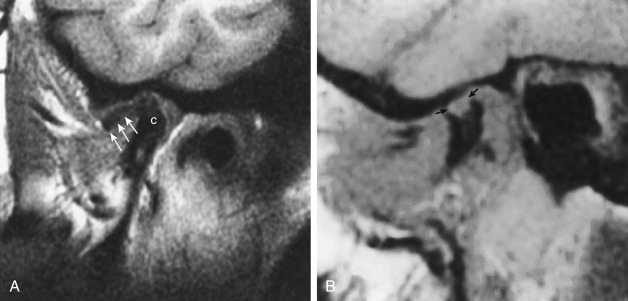
In the long term, degenerative changes in the joint may develop and include narrowing, osteophytic bird-beaking of the condyle, eburnation, ankylosis, joint mice/loose bodies, and fragmentation.
Rheumatoid arthritis may also affect the TMJ. Usually erosions of the condyle are seen with a soft-tissue component (see Fig. 14-24, B ). Effusions and meniscal perforations also complicate the rheumatoid joint. Other arthritides include septic arthritis, gout, and pseudogout of the TMJ.
The TMJ may be affected by such lesions as pigmented villonodular synovitis (characterized by hemosiderin or other blood products seen as dark signal on T2 ∗ MR), synovial chondromatosis ( Fig. 14-25 ), chondroid masses ( Fig. 14-26 ) and tumoral calcinosis.
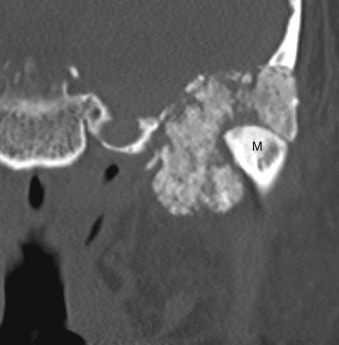
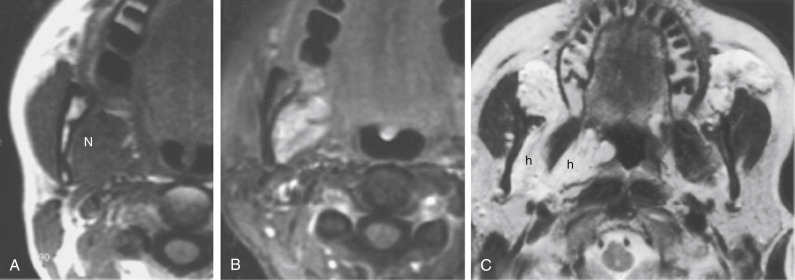
Become a Clinical Tree membership for Full access and enjoy Unlimited articles
If you are a member. Log in here